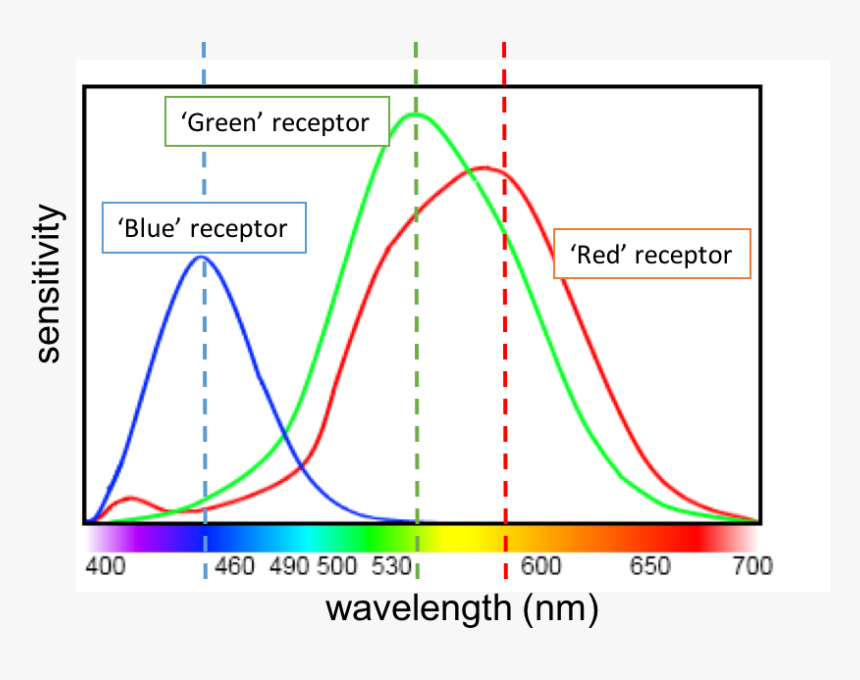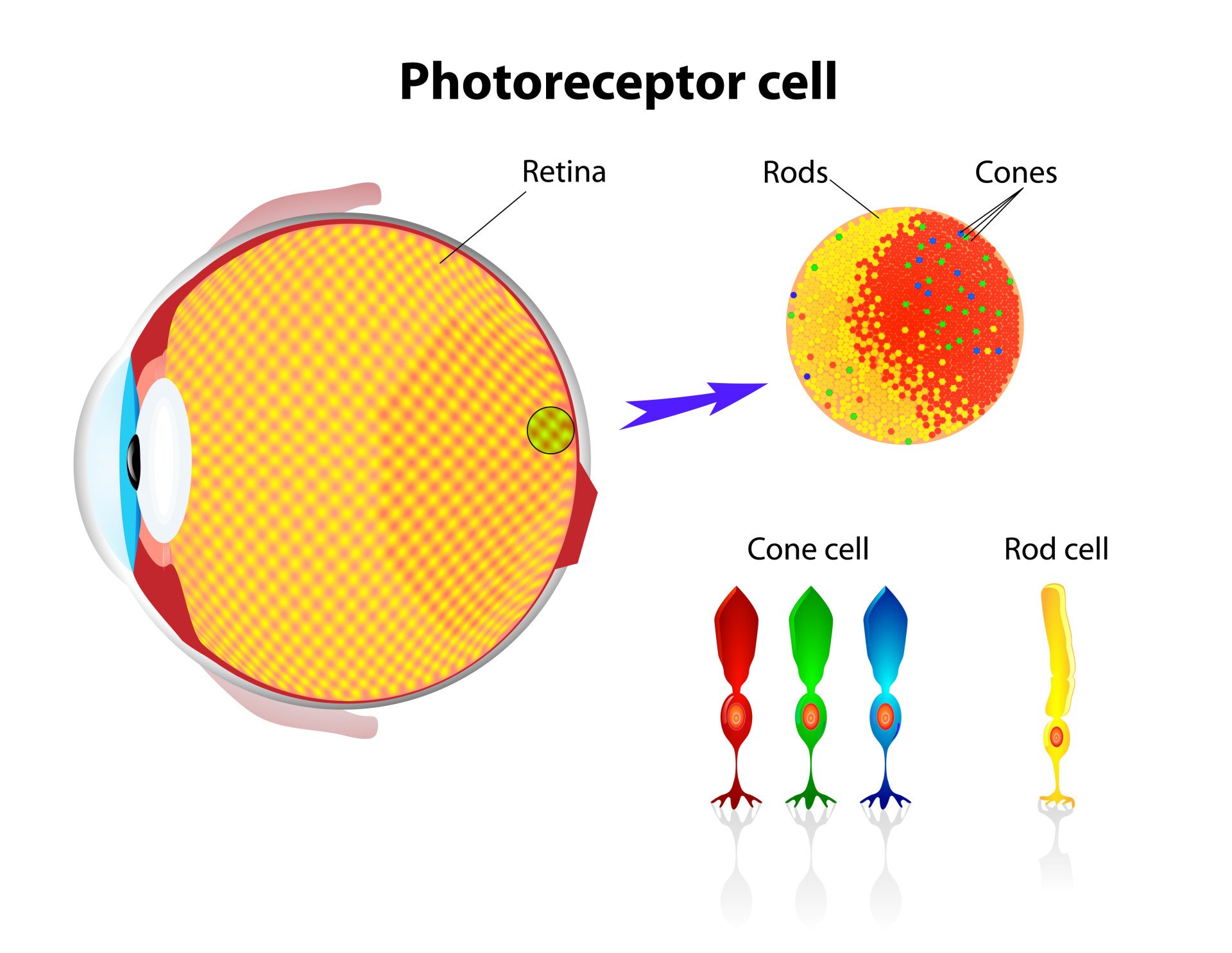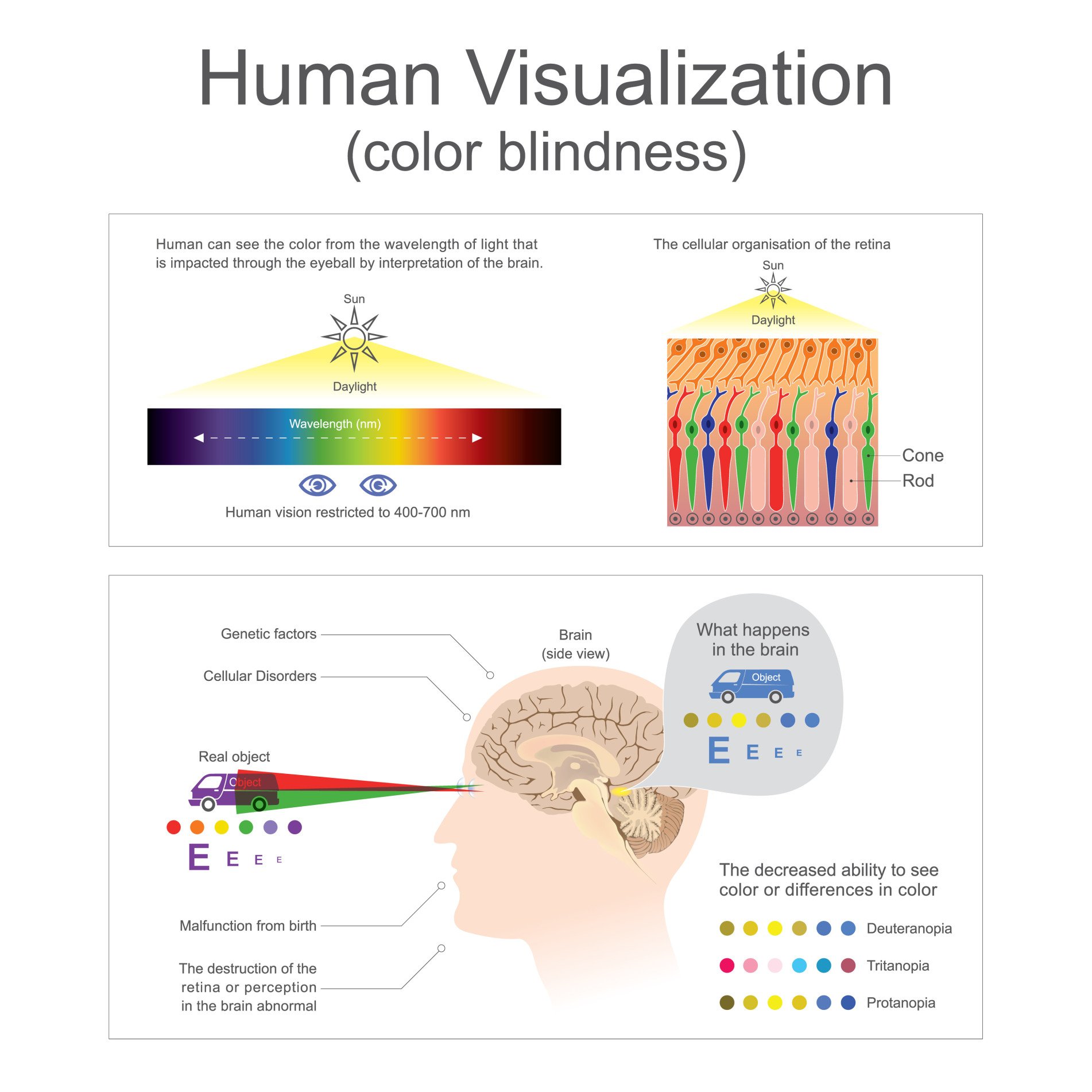On This Page:
Key Takeaways
- The trichromatic theory, which derives from the combined works of the 19th-century scientists Young and Helmholtz, says that there are three different cone systems in the eye that perceive three types of color: blue, green, and red.
- According to trichromatic theory, every combination of color perceived by the brain is a combination of blue, green, and red.
- On a physiological level, the cones in the brain that correspond to blue, green, and red are called S-, M-, and L-cones, respectively. A loss of S-cones results in blue-yellow color blindness, while a loss of M- or L-cones results in red-green color blindness.
- The traditional foil to the trichromatic theory of color vision is the opponent process theory, which says that the perception of color is mediated by red/green, blue/yellow, and black/white channels. Both theories are accurate but describe how color is perceived on different neurological levels.
How Color Vision Works
We can see many colors but only have three types of cones that receive information about color.
Normal-sighted individuals have three different types of cones that mediate color vision. Each of these cone types is maximally sensitive to a slightly different wavelength of light.
According to the trichromatic theory of color vision, all colors in the spectrum can be produced by combining red, green, and blue.
The three types of cones are each receptive to one of the colors.

Background
The trichromatic theory of color vision, first discussed by Young and Helnotz, postulates that there are three different retinal cones in the eye that are sensitive to blue, green, and red, respectively.
Trichromatic theory indicates that we can receive 3 types of colors (red, green, and blue) and that the cones vary the ratio of neural activity (Like a projection T.V.). The ratio of each color to the other then determines the exact color that we see.
This theory is derived from experiments on the color mixture in which all hues were able to be matched by a mixture of three primary colors.
Scientific interest in color began with research of Newton into light and colors in the latter part of the seventeenth century.
Notably, Newton discovered that all colors are reproducible with a mixture of at least two kinds of light.
Newton later suggested that light rays excite vibrations in the retina and that when these signals are transmitted to the brain, they result in people experiencing color.
Young Helmholtz Theory
In the eighteenth century, physicists asserted that a minimum of three primary colors was necessary to reproduce all colors. Different physicists concluded that different colors were primary.
In the later part of the century, Giros de Gentilly argued not only that physical light was caused by the mixture of three colors, but also that the physical mechanism that leads to color perception in the retina was facilitated by three kinds of membranes or molecules, each selectively sensitive to one of three kinds of light (Balaraman, 1962).
Further, Giros de Gentilly speculated that defective color vision was due to the inactivity of one of these color-sensing membranes.
As physics revealed that white light consists of an infinite number of rays, Thomas Young (1802) modified Newton’s original theory about the perception of color. Young proposed that each color-sensitive part of the nerve that senses color consisted of three portions, one for each color.
After the autopsy of famous colorblind physicist Thomas Dalton, Young ascribed Dalton’s lack of color vision to the absence or paralysis of the fibers of the retina, which perceive red (1807).
By the mid-nineteenth century, Helmholtz revived Young’s theory of color vision through his experiments but later rejected it (Balaraman, 1962).
Helmholtz used color-matching experiments where participants altered the amounts of three different wavelengths of light to match a test color.
Although participants could not match the colors if they used only two wavelengths, they could match any color in the spectrum if they used three.
According to the Young-Helmholtz theory of color vision, there are three perceiving elements in the retina: red, green, and blue.
The perception of other colors arises from the combined stimulation of these red, green, and blue receptors; meanwhile, the deficiency or absence of any of these elements results in an inability to discern that color and the misperception of any other color where it plays a role.
In essence, the Young-Helmholtz theory of color vision has these principles.
Color Receptors
The three cone receptors responsible for color vision were not discovered until several decades after the proposal of the theory of trichromatic visions.

Researchers discovered that the pigments in the cones, receptors in the retina, have different levels of absorption. There are three different cone receptors: one for short wavelengths, another for medium wavelengths, and one for long wavelengths.
These are called the S-cone, M-cone, and L-cone, respectively. Blue is a short-wavelength, high-frequency form of light, red is a long-wavelength low-frequency, and green is somewhere in between; together, these three colors cover the whole spectrum of light visible to humans.
Of these cones, the S-cones are the most distinctive. For one thing, there are many more M- and L-cones than there are S-cones; S-cones make up just 5% of the total number of cones in the retina (Parker, 2019).
Secondly, S-cones are less sensitive to light than M- and L-cones. This means that they are less important to how humans perceive brightness but still as important in perceiving color as other cones (Parker, 2019).
To illustrate how these cone systems lead to color perception, consider a monochromatic green light hitting the retina. The green light has a medium wavelength.
This means that the reflected light would trigger a very weak response in the S-cone, a strong response in the M-cone, and a relatively weak response in the L-cone.
This pattern of activation corresponds with a person’s experience of green.
The perception of color by the brain requires the activation of at least two of these cones.
The brain must also interpret information about both the wavelength and intensity of the light that is stimulating it.
In comparing the input from each cone that has been stimulated, the brain can interpret the color of the source that is stimulating the retina.
Trichromatic Theory and Opponent Process Theory
It was once common for authors to put the trichromatic theory of color vision against the opponent processes theory.
However, both the trichromatic and opponent-process theory of color vision describe color as it is perceived in different parts of the brain.
The trichromatic theory of color vision and the opponent-process theory are not mutually exclusive. Research has shown they apply to different levels of the nervous system.
On the one hand, the trichromatic theory correctly determines how the cone receptor detects different wavelengths of light.
On the other hand, the opponent process theory (Edwald Hering, 1878) is also necessary to understand the full picture because it explains how these cone receptors connect to the nerve cells that determine how humans actually perceive any kind of color in their brains.
A simpler way of explaining the relationship between the two is that trichromatic theory explains how the actual visualization of colors occurs at the receptors, while OPT theory is focused on interpreting the color vision occurring at the neural level.
For visual processing on the retina, the trichromatic theory applies: the cones are responsive to three different wavelengths represented red, blue, and green.
But once the signal moves past the retina on its way to the brain, the cells respond in a way consistent with opponent-process theory.
Rather than being opposed or in contradiction to each other, the theories are enmeshed, explaining different aspects of color vision (Parker, 2019).
According to opponent process theory, color is coded in opponent pairs: black-white, yellow-blue, and green-red.
Opponent process theories postulate that information about color is transmitted by three channels in the brain. One of these channels transmits either green or red but cannot do both at the same time.
A second channel transmits either blue or yellow, and a third transmits either black or white.
There are several effects that can be explained by opponent-process, but not trichromatic color theory.
One of these is the tendency for someone to see the opposite color of the one they were looking at when they look away from the color source (Parker, 2019).
To illustrate, consider an eye perceiving an image of the color green. The portion of the retina that is stimulated by this green image is activating the green/red channels in the brain such that they signal the sensation of green.
After viewing the figure for an extended period of time, however, the components in the brain associated with green become fatigued.
When someone moves their gaze to an image that stimulates the green and red channels equally — such as a white sheet of paper — the fatigued green components of the change produce a weaker response than the red channels, creating the sensation that someone is seeing red.
Another example of an effect that can be explained by opponent-process theory but not the trichromatic theory of color vision is how people label the colors they see.
While observers sometimes report that a mixture, for example, is both red and yellow, they do not say that it contains both red and green at the same time.
This can be explained by the idea that the green/red channel can only transmit red or green, but not both at the same time (Parker, 2019).
Examples
Four-Cone Systems: An Exceptional Case
People are not necessarily limited to three cone color vision. In fact, some people may have functional four-cone color-sensing systems that allow them to see more colors than people with three cones do (Parker, 2019).
Gabriele Jordan identified a woman with a functional four-cone system, which seemingly resulted in her seeing different colors in situations where most people would see just one color (Jordan, Deeb, Bosten, & Mollon, 2010).
Nonetheless, Jordan and her colleagues believe that functional four-cone vision is rare. Jordan, in her study, looked specifically at the genetics that causes some women to have four-cone systems and then tested behaviorally whether some women could discriminate more colors.
Because many genes for color vision are on the X chromosome, men are more likely to be color deficient and less likely to have an extra cone system than women.
Although many women had a genetic mutation that gave them what appeared to be an extra cone system in their retina, only one of these women could discriminate colors that looked identical to the other participants or controls with three cones (Parker, 2019).
Color-Blindness
The trichromatic theory of color vision predicts what happens when people lose one of the classes of cones in their retina: color-blindness.

In the most classic form of color blindness, color-deficient people cannot distinguish between reds and greens. A large amount of evidence suggests that red-green color deficiency is a result of the loss of the S-cones.
Meanwhile, blue-yellow color deficiency results from the loss of S-cones.
Color-matching experiments show that color-deficient people with only two cones only need two light sources to match the color of one monochromatic light, further corroborating the evidence that color blindness results in a loss of cones (Parker, 2019).
Further Information
Lee, B. B. (2008). The evolution of concepts of color vision. Neurociencias, 4(4), 209.
References
Balaraman, S. (1962). Color vision research and trichromatic theory: A historical review. Psychological Bulletin, 59 (5), 434.
Hering, E. (1878). Opponent-process Theory. Expanded by Solomon.
Jordan, G., Deeb, S. S., Bosten, J. M., & Mollon, J. D. (2010). The dimensionality of color vision in carriers of anomalous trichromacy. Journal of Vision, 10 (8), 12-12.
Parker, D. (2019). Color Perception. SAGE Publications.
Young, T. (1802). II. The Bakerian Lecture. On the theory of light and colors. Philosophical transactions of the Royal Society of London, (92), 12-48.
Young, T. (1802). II. The Bakerian Lecture. On the theory of light and colours. Philosophical transactions of the Royal Society of London, (92), 12-48.

